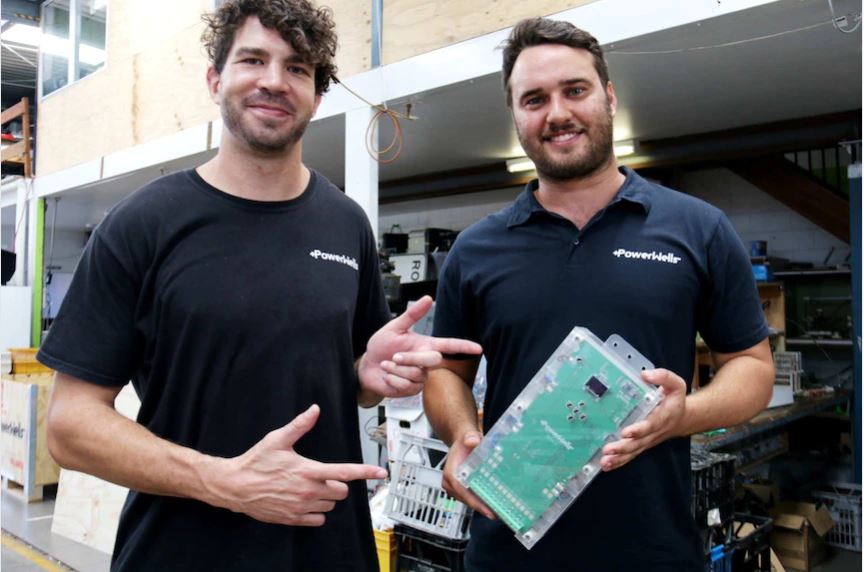By Jessica Stewart, ABC News
A Queensland social enterprise is turning electronic trash into a global treasure, repurposing old laptop batteries to create a solar-powered solution for poverty-stricken families across the world.
It all began three-and-a-half years ago, at a start-up weekend at Substation 33 — an e-waste recycling facility in Kingston, south of Brisbane.
Town planner Nicholas Kamols and social entrepreneur Brad Clair had never met before, but within hours the idea of PowerWells was born and their lives changed forever.
“The task was to come up with a solution to an environmental or social problem, and one of our group members was from Indonesia,” Mr Clair said.
“He was telling us how he used to travel from his village to the next village just to charge his phone, which was something like 250 kilometres away.
“So, working at an e-waste recycling facility, we decided to tackle that problem using recycled laptop batteries.”
In Australia, only 2 per cent of lithium-ion batteries are currently being recycled, which means 98 per cent potentially end up in landfill.
“If we can use batteries that are going to end up in landfill anyway, we might as well use those to power people who don’t have electricity,” Mr Clair said.
“We actually put a whole heap of batteries into a paint bucket and we thought that was good enough.
“We had a solar panel that connected into it, we had three little USB outlets so you could charge your phone and then, on the inside it was full of recycled laptop batteries.”
Ten days later, the pair boarded a plane to Indonesia with their bold idea and a determination to leave a mark on the energy-poverty crisis crippling a large percentage of Indonesia’s population.
Making it here is just the start
Indonesia has a population of 270 million people, of which 10 per cent would be considered “energy poor” — that means 27 million Indonesians without power.
Most of these residents are living on less than a dollar a day and are burning kerosene candles to have just one small light at night.
Kerosene is extremely harmful; it’s bad for lung health, especially in children, and often those using candles are breathing carbon residue, impacting their life expectancy.
This is a scenario repeated in poverty-stricken countries across the globe.
“There’s so much potential in this [PowerWells],” Mr Kamols said.
“There are 800 million people around the world who lack access to electricity, and this is a solution that ticks so many boxes.”
Essentially, a PowerWell is a 90 per cent plug-and-play home solar system, made mostly of lithium-ion batteries and perspex from old monitors and TVs, designed for rural off-grid homes.
“It has four lights and four USB ports. It also has a 12-volt output that’ll be for laptops and anything essential like that,” Mr Kamols said.
“Funnily, in Indonesia the word ‘solar’ actually means ‘diesel’ so the first trip there, we were saying it was a solar-powered product and people were looking for where you put the liquid — we’ve had a few road bumps along the way.”
One hundred PowerWells were shipped to Indonesia this week, and another 157 are going next month.
“Making it here in Australia is limited … the big impact that we have is replicating it all around the world and that’s what we’re really focusing on,” Mr Kamols said.
Mr Clair said they wanted to distribute the blueprint across the globe.
“We want to try and set up battery re-purposing facilities all over the world where people can pull apart their own e-waste and we just tell them how to build it,” he said.
“Then we can just send over the printed circuit boards, so everything will be mostly manufactured in their own country.
“They’ll be using their waste, their labour.”
An idea befitting a Duke
The current prototype of the PowerWell is the third iteration the pair landed on after their idea came to life.
It took a trip to the other side of the world and a major mishap for them to move on from their first prototype, “the paint bucket”.
“We were really lucky, we won the Pitch@Palace competition in Australia and part of our prize was to pitch PowerWells at St James’s Palace in the UK, to some of the royal family,” Mr Clair said.
Pitch@Palace was founded in 2014 by Prince Andrew, the Duke of York, as a unique platform for entrepreneurs.
“We actually had to build a PowerWell over in the UK because we couldn’t take one on the plane with us,” Mr Clair said.
“I left it in the hotel room and the cleaner thought it was a bomb.
“They evacuated 140 rooms in the hotel and set-up a 4-kilometre radius around the building.
“But we spoke to the police after it all and they actually congratulated us on the work that we were doing.”
Power source ‘a giant step’
The PowerWells will be launched on one of the eastern islands, Sumba, once they arrive in Indonesia.
Sarah Hobgen, an Australian who lives on the island and who is managing director of Sumba Sustainable Solutions, will help distribute them across villages, with the help of 52 local agents.
“We’ve chosen two agents to pilot the first round [and] who’ll be going to a few villages,” Ms Hobgen said.
“In those villages we have women who are village agents and they receive a small percentage of the money that’s collected, so it’s a small source of income for them.
“We are given codes from the team at PowerWells so people will pay for them in instalments — less than $5 a month.
“The codes will then activate those units and that gives them 30 days of light, so they’re paid off in micro-instalments over three years.
Even then, some households will not be able to afford them.
“One of the things we found is that competition for cash is really high,” Ms Hobgen said.
“People are worried about purchasing food and clothing before lighting so we’re now going to trade people for things that they couldn’t otherwise sell easily at the market — bamboo and coconut oil.”
Ms Hobgen has seen the impact firsthand.
“It means that [people] can have lighting overnight, they study more, they socialise more and they do more work that they can be paid for, things like making woven mats,” she said.
“So, it increases their wellbeing, but it also increases their source of income.
“The idea of this is just to get them onto the first rung of the energy ladder; eventually they might be able to get fans, refrigerators, all of these kinds of things that we take for granted.”
One PowerWell provides access to one household of about eight to 10 people on average, but often people are allocating some of their power-consumption to neighbours as well.
“It’s a giant step for a lot of these communities,” Ms Hobgen said.


